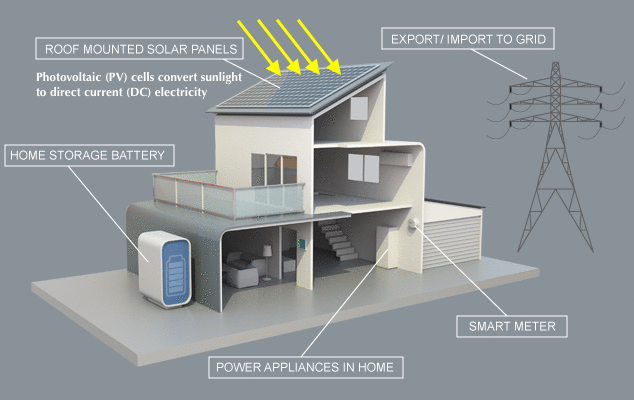WE MAKE GOING SOLAR EASY
HOW SOLAR WORKS

WHAT IS SOLAR
Solar Modules
Purpose: Solar Modules convert sunlight into DC electricity via the Photovoltaic Effect which can be used to charge batteries or inverted to AC power to power the house.
Types: Solar Modules can be classified into two major categories: wafer based or thin film. The main wafer based technology is crystalline silicon (mono or poly) and the main thin film technologies are cadmium telluride (CdTe), copper indium gallium diselenide (CIS/CIGS) and amorphous silicon (a-Si).
Comparison: Crystalline silicon constitutes approximately 90% of global module production and is the most mature PV technology.
- The main advantages are; it delivers efficiency in the range of 15- 25%, high stability, ease of fabrication, high reliability and longevity. Silicon is more environmentally friendly when it is time to recycle.
- The main disadvantages are; more expensive, rigid and fragile, efficiency is much more negatively affected by higher operating temperatures and due to the wiring layout is more prone to shading.
Thin film materials absorb light 10 -1 00 time more efficiently than silicon, allowing the use of thin film, lowering the use of material and hence their costs.
- The main advantages are; lower cost, flexible, are less affected by higher temperatures and less prone to shading due to how they can be wired.
- The main disadvantages are; mostly lower efficiency in the range of 10- 12% (some products though have achieve 20%), lower durability, potential material shortage (Indium and Tellurium), material toxicity (Cadmium is toxic). Thin films are also more difficult to recycle.
To Learn More: Please read our ‘Solar and Solar Module’ blog and white paper (coming soon).
Storage
For this section we will mainly focus on electrochemical storage, i.e. (secondary/rechargeable) Batteries pertaining to Solar energy.
Purpose: Batteries store excess solar energy to be used later when the load requirement is higher than the solar production (one example is at night). Batteries can also be used as a back up during grid failure.
Types: The main types are Lead Acid, Nickel Cadmium (NiCd), Nickel- metal hydride, Lithium ion and sodium based batteries. The prominent ‘Solar’ battery is lead acid and the most upcoming and promising is Lithium Ion.
Comparison: Lead Acid batteries have been used since the 19th century and the most common and incumbent battery type.
- The main advantages are; a mature technology with established recycling infrastructure, low initial/ upfront cost.
- The main disadvantages are; poor ability to operate in partial state of charge, relatively poor depth of discharge and short life span (2000- 3000 cycles at 50% DOD), results in a higher $/usable kWh/cycle, worse charging and discharging characteristics and worse high working temperature characteristics.
Lithium ion batteries are available in multiple chemistries depending on the type of use. The main types are Lithium Nickel Cobalt Aluminium Oxide (NCA) which is mainly used in electronic Vehicles (EV including Tesla cars), Lithium Nickel Manganese Cobalt oxide (NMC) is mainly used in storage (a variant is used in Tesla Powerpack and Powerwall) and Lithium Iron Phosphate (LFP) is also used for solar storage.
- The main advantages are; lower $/usable kWh/ cycle, better charging and discharging characteristics, better high temperature characteristic, power and energy dense, can be deep discharged and have a longer cycling life span (approx. 5000 at 100% DOD).
- The main disadvantages are; higher upfront cost, safety issue with overheating if not properly managed, worse low temperature characteristics, little recycling infrastructure.
To Learn More: Please read our ‘Solar and Storage’ blog and white paper (coming soon).
Charge Controllers
Purpose: The main function of a charge controller is to safely charge a solar battery at the correct charge rates and protect the battery from overcharge and also maintains the battery charging voltage at an optimal (prevent overvoltage) while blocking reverse currents.
Types: The two main types of solar charge controllers (SCC) are the PWM and the MPPT. These are essentially two different types of charging methods and SCC use to charge batteries.
Comparison: PWM stands for pulse width modulation where the controller sends out a series of short charging pulses to the battery – a rapid ‘on- off’ switch. The rate and duration of pulses depends on the state of charge.
- The main advantages are; 33- 50% the cost of MPPT, longer lifespan, smaller size, good low cost solution for small system when module temperatures are high (45- 75 C).
- The main disadvantages are; in most cases is less efficient way of charging (10- 40% less), cannot be used efficiently with 60 cell panels.
MPPT stands for maximum power point tracking, i.e. an adaptive algorithm that follows the maximum power point of a PV array and then adjusts the incoming voltage to extract the most power from the panels. The excess voltage is converted to extra charging current at the charging voltage without loss of power.
- The main advantages are; highest charging efficiencies (10- 40% greater), can be used with 60 cell panels, more flexibility in design.
- The main disadvantages are; 2 to 3 times more expensive than PWM and have a shorter lifespan due to more electronic components.
To Learn More: Please read our ‘Solar and Solar Charge Controllers’ blog (coming soon).
Inverters
Purpose: The main function of an inverter is to convert DC electricity from batteries and solar panels to grid and appliance friendly AC electricity.
Types: There are three main types of inverters; Grid tied PV inverters, Hybrid Solar Inverters and Battery Inverters.
Comparison: PV inverters require the grid or a generator to mirror the voltage and frequency, they are usually programmed to curtail if there is no reference.
- The main advantages are; time tested and used widely in grid- connected applications, countless number of products.
- The main disadvantages are; possible to include batteries but as an AC coupled solution which needs another inverter and is more costly.
A hybrid inverter, also referred to as a multi mode inverter can simultaneously manage inputs from both solar panels and battery banks.
- The main advantages are; all- in- one invert solution for grid connected solar plus storage systems, can be installed with batteries for future expansion, long history of use in off- grid systems.
- The main disadvantages are; less design flexibility than modular solutions which use separate PV and battery inverters, less efficient.
A battery inverter, manages the charging and discharging of batteries and converts DC to AC and vice versa in order to supply loads or charge batteries. They can be installed with solar systems for back- up and other purposes and can be easily retrofitted onto existing solar PV systems.
- The main advantages are; modular leading to great design flexibility, easily retrofitted for addition of battery, sturdy and durable.
- The main disadvantages are; more expensive than PV inverters.
To Learn More: Please read our ‘Solar and Inverter’ blog (coming soon).













Blog
News
Customer Reviews
Solar Facts
Kenya, as per our conservative calculations would need just 120 square kilometers of solar panels and 0.53 square kilometers of energy storage, in order to full power the country (as per current generation and demand requirements). This is equivalent to less than 0.2% of the area of Turkana which is 68,680 square kilometers.
The sunlight we receive for just an hour is enough to generate energy for one year for the whole world.
When there’s a huge solar energy spill, it’s just called a ‘nice day‘
Unlike other energy sources, such as coal and oil whose reserves will diminish, the sun is here to stay and so is the energy we can gain from it.
Get In Touch
Ask Us

 Save Money
Save Money Reliable Storage
Reliable Storage Reliable Power
Reliable Power Energy Independence
Energy Independence Monitor 24/7
Monitor 24/7 Financing
Financing Be Green
Be Green Great Investment
Great Investment Increase Efficiency
Increase Efficiency


